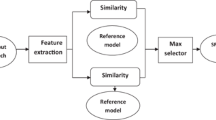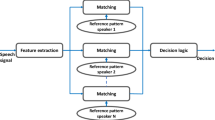Abstract
Traditional biometric systems are subjected to several attacks. If the original database of human biometrics is compromised, the biometric data is lost forever. This paper presents a sophisticated implementation of one of the watermarking algorithms in the field of cancelable speaker identification. A watermark strength factor is used to control the level of intended distortion created in the speech signal prior to the identification process. The practical simulation of the proposed system proves that it is possible through a watermarking algorithm to distort speech signals intentionally to generate cancelable speech templates.









Similar content being viewed by others
References
Abaza, A., Ross, A., Hebert, C., Harrison, M. A. F., & Nixon, M. S. (2013). A survey on ear biometrics. ACM Computer Surveys, 45(2), 2.
Abozaid, A., Haggag, A., Kasban, H., & Eltokhy, M. (2018). Multimodal biometric scheme for human authentication technique based on voice and face recognition fusion. Multimedia Tools and Applications, 78(12), 16345–16361. https://doi.org/10.1007/s11042-018-7012-3.
Abualadas, F. E., Zeki, A. M., Al-Ani, M. S., & Messikh, A. E. (2019). Speaker identification based on hybrid feature extraction techniques. International Journal of Advanced Computer Science and Applications (IJACSA), 10(3), 2019.
Agarwal, C., Mishra, A., Sharma, A., & Bedi, P. (2014). Optimized gray-scale image watermarking using DWT–SVD and firefly algorithm. Expert Systems with Applications, 41(17), 7858–7867.
Ali, M., & Ahn, C. W. (2014). An optimized watermarking technique based on self-adaptive DE in DWT–SVD transform domain. Signal Processing, 94, 545–556.
Ansari, I. A., Pant, M., & Ahn, C. W. (2016). Robust and false positive free watermarking in IWT domain using SVD and ABC. Engineering Applications of Artificial Intelligence, 49, 114–125.
Bender, W., Gruhl, D., & Morimoto, N. (1996). Techniques for data hiding. IBM Systems Journal, 35(3–4), 313–336.
Bolle, R. M., Connel, J. H., & Ratha, N. K. (2002). Biometrics perils and patches. Pattern Recognition, 35(12), 2727.
Bowyer, K. W., Hollingsworth, K., & Flynn, P. J. (2008). Image understanding for iris biometrics: A survey. Elsevier Journal: Computer Vision and Image Understanding, 110(2), 281.
Cox, I., Miller, M., Bloom, J., Fridrich, J., & Kalke, T. (2007). Digital watermarking and steganography (2nd ed.). Burlington, MA: Morgan Kaufmann.
Delac, K., & Grgic, M. (2004). A survey of biometric recognition methods. In: Proceedings of the 46th international symposium on electronics in marine, Zadar, Croatia, June, 2004, (pp. 184–193).
Freund, Y., & Schapire, R. E. (1977). A Decision-theoretic generalization of on-line learning and an application to boosting. Journal of Computer and System Sciences, 55, 119–139.
Friedman, J., Hastie, T., & Tibshirani, R. (2000). Additive logistic regression: A statistical view of boosting (with discussion and a rejoinder by the authors). Annals of Statistics, 28, 337–407.
Ganic, E., & Eskicioglu, A. M. (2004). Robust DWT-SVD domain image watermarking: Embedding data in all frequencies. In: MM&SEC’04 (pp. 166–174).
Goudelis, G., Tefas, A., & Pitas, I. (2008). Emerging biometric modalities: A survey. The Journal of Multimodal User Interfaces, 2, 217.
Gui, Q., Jin, Z., & Xu, W. (2014). Exploring EEG-based biometrics for user identification and authentication. In IEEE signal process. Medicine and biology symposium, Philadelphia, PA, December, 2014, (pp. 1–6).
Hartung, F., & Kutter, M. (1999). Multimedia watermarking techniques. Proceedings of the IEEE, 87(7), 1079–1107.
Jain, A. K., Ross, A., & Prabhakar, S. (2004). An introduction to biometric recognition. IEEE Transactions on Circuits and Systems for Video Technology, 14(1), 4.
Jaiswal, S., Bhadauria, S. S., & Jadon, R. S. (2011). Biometric: Case study. Journal of Global Research in Computer Science, 2(10), 19.
Kaur, G., & Verma, C. K. (2014). Comparative analysis of biometric modalities. International Journal of Advanced Research in Computer Science and Software Engineering, 4(4), 603.
Kaur, M., & Mittal, P. (2018). Speaker recognition based on feature extraction in clean and noisy environment. International Journal for Research in Applied Science & Engineering Technology (IJRASET), 6, 3329–3337.
Khalifa, W., Salem, A., Roushdy, M., & Revett, K. (2012). A survey of EEG based user authentication schemes. In 8th international conference on informatics and systems, Cairo, May, 2012, (pp. 55–60).
Lai, C. C., & Tsai, C. C. (2010). Digital image watermarking using discrete wavelet transform and singular value decomposition. IEEE Transactions on Instrumentation and Measurement, 49, 3060–3063.
Mohammed, G. N., Yasin, A., & Zeki, A. M. (2012). Digital image watermarking, analysis of current methods. In 2012 international conference on advanced computer science applications and technologies (ACSAT) (pp. 324–329). IEEE.
Muhermagic, E., & Furt, B. (2004). Survey of watermarking techniques and applications. Multimedia Watermarking Techniques and Applications, 3, 130.
Mukherjee, D., Maitra, S., & Acton, S. (2004). Spatial domain digital image watermarking of multimedia objects for buyer authentication. IEEE Transactions on Multimedia, 6(1), 1–15.
Odinaka, I., Lai, P.-H., Kaplan, A. D., O’Sullivan, J. A., Sirevaag, E. J., & Rohrbaugh, J. W. (2012). ECG biometric recognition: A comparative analysis. IEEE Transactions on Information Forensics and Security, 7(6), 1812.
Plamondon, R., & Srihari, S. N. (2000). Online and o®-line handwriting recognition: A comprehensive survey. IEEE Transactions on Pattern Analysis and Machine Intelligence, 22(1), 63.
Podilchuk, C. I., & Delp, E. J. (2007). Digital watermarking: algorithms and applications. IEEE Signal Processing Magazine, 18, 33–46.
Ratha, N. K., Chikkerur, S., Connell, J. H., & Bolle, R. M. (2007). Generating cancelable fingerprint templates. IEEE Transactions on Pattern Analysis and Machine Intelligence, 29(4), 561.
Ratha, N. K., Connel, J. H., & Bolle, R. (2001). Enhancing security and privacy in biometricsbased authentication systems. IBM System Journal, 40(3), 614.
Rathageb, C., & Hammerle-Uhl, A. (2011). A survey on biometric cryptosystem and cancelable biometrics. EURASIP Journal on Information Security, 1, 3.
Shah, S. C., Kusiak, A., & O’Donnell, M. A. (2006). Patient-recognition data-mining model for BCG-plus interferon immunotherapy bladder cancer treatment. Computers in Biology and Medicine, 36, 634–655.
Soliman, N. F., Mostfa, Z., Abd El-Samie, F. E., & Abdalla, M. I. (2017). Performance enhancement of speaker identification systems using speech encryption and cancelable features. International Journal of Speech Technology, 20(4), 977–1004.
Swanson, M. D., Kobayashi, M., & Tewfik, A. H. (1998). Multimedia data embedding and watermarking technologies. Proceedings of the IEEE, 86(6), 1064–1087.
Vafaei, M., Mahdavi-Nasab, H., & Pourghassem, H. (2013). A new robust blind watermarking method based on neural networks in wavelet transform domain. World Applied Sciences Journal, 22(11), 1572–1580.
Yoshioka, T., Sehr, A., Delcroix, M., & Kinoshita, K. (December, 2012). Survey on approaches to speech recognition in reverberant environments. In Asia-Pacific signal and information processing association annual summit and conference (APSIPA ASC), Hollywood, (pp. 1–4).
Zanuy, M. F. (2007). On-line signature recognition based on VQ-DTW. Elsevier Journal: Pattern Recognition, 40(3), 981.
Zayaraz, G., Vijayalakshmi, V., & Jagadiswary, D. (2004). Securing biometric authentication using DNA sequence and Naccache Stern Knapsack cryptosystem. In International conference ON control, automation, communication and energy conservation, Perundurai, Tamilnadu, June, 2009, 1–4.
Zuo, J., Ratha, N. K., & Connel, J. H. (2008). Cancelable iris biometrics. In Proceedings of the 19th international conference pattern recognition, Tampa, FL, December 8–11, 2008, (pp. 1–4).
Author information
Authors and Affiliations
Corresponding author
Additional information
Publisher's Note
Springer Nature remains neutral with regard to jurisdictional claims in published maps and institutional affiliations.
Rights and permissions
About this article
Cite this article
Abdelwahab, K.M., El-atty, S.A., Brisha, A.M. et al. Efficient cancelable speaker identification system based on a hybrid structure of DWT and SVD. Int J Speech Technol 25, 279–288 (2022). https://doi.org/10.1007/s10772-020-09778-9
Received:
Accepted:
Published:
Issue Date:
DOI: https://doi.org/10.1007/s10772-020-09778-9




